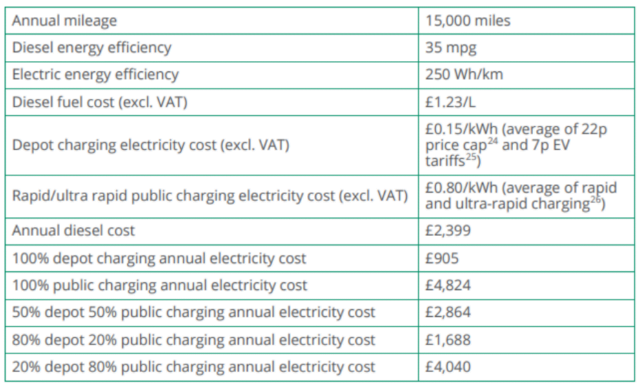The Association for Renewable Energy and Clean Technology (REA) and the Energy Saving Trust (EST) have released a white paper revealing that operators can save approximately £1,500 per year for each light commercial vehicle (LCV) transitioned to electric, and around £3,500 per year for each HGV.
These cost reductions are grounded in research showing that electric vehicles only require 25-30% of the energy needed by their diesel counterparts to achieve comparable performance. The Energy Saving Trust highlighted that these projected savings make the economic case for switching to electric vehicles even stronger, demonstrating both financial and efficiency advantages.
[caption id="attachment_2928" align="aligncenter" width="640"]

LCV and HGV charging costs summary (Energy Saving Trust). Based on a medium LCV driving 15,000 miles a year (60 miles per day, 250 days a year).[/caption]
The REA and EST report provides a comprehensive guide to fleet electrification, offering step-by-step advice, showcasing cost-effectiveness and efficiency savings, and addressing current adoption barriers.
Speaking about the report, Future of Roads Minister Lilian Greenwood was quoted as saying,“ Our roads are undergoing a technological revolution, and fleets will play a big part. A cleaner greener transport network is a key priority for this government, which is why we have plug-in grants available for vans and trucks and programmes aimed at scaling up zero-emission HGVs, to decarbonise road freight.”
The benefits of switching to an EV fleet include reduced costs, corporate responsibility, regulatory compliance (including meeting Scope 1 and Scope 2 emissions), and staying ahead of government targets such as the UK Zero Emissions Vehicle (ZEV) Mandate.
However, the cost of adoption remains a huge barrier.
Support and grants for EV adoption
The plug-in van grant
The plug-in van grant (PIVG) was launched in 2012 to help bridge the price gap between the cost of ultra-low emission vans and diesel vans. It was extended to trucks, also referred to as heavy goods vehicles (HGVs) in 2016. Only vehicles that have been approved by the government are eligible, and the level of discount depends on the type of vehicle.
Small Van Plug in Grant: Small vans are eligible for up to £2,500 discount. These vans must be under 2,500kg, produce less than 50 g/km of CO2 and be able to travel at least 60 miles without any emissions from the tailpipe.
Large Van Plug in Grant: Large vans are eligible for a discount of up to £5,000. These vans must be between 2,500kg and 4,250kg in gross vehicle weight; produce less than 50 g/km of CO2 and be able to travel at least 60 miles without any emissions from the tailpipe.
Small Truck Plug in Grant (N2 Vehicles): Small trucks are eligible for a discount of up to £16,000. These trucks must be between 4,251kg and 12,000kg; have CO2 emissions of at least 50% less than the equivalent conventional Euro VI vehicle that can carry the same capacity, and be able to travel at least 60 miles without any emissions from the tailpipe.
Large Truck Plug in Grant (N3 Vehicles): Large trucks are eligible for a discount of up to £25,000. These trucks must be heavier than 12,000kg in gross vehicle weight; have CO2 emissions of at least 50% less than the equivalent conventional Euro VI vehicle that can carry the same capacity, and be able to travel at least 60 miles without any emissions from the tailpipe.
More information and lists of eligible vehicles can be found here.
Electric vehicle infrastructure grant for staff and fleets
The grant provides small and medium-sized businesses money off the cost of installing electric vehicle (EV) chargepoints and supporting infrastructure for their staff and fleet vehicles. The grant covers 75% of the cost of the work, up to a maximum of £15,000. Businesses can apply for up to £350 per chargepoint socket installed, and up to £500 per parking space enabled with supporting infrastructure. You can receive up to 5 grants across 5 different sites.
More information can be found here.
Considering the transition to an EV fleet?
If you’re considering the transition to an electric fleet, this blog covers key considerations for fleet managers, from lower maintenance costs, VED, and congestion charges, to tax considerations.
With EV infrastructure still relatively new, many fleet managers are also concerned about charger availability. The reality is, investment in infrastructure and battery technology has made range-anxiety a thing of the past. At The Fuel Store, we have teamed up with Paua, the UK’s #1 Electric Vehicle Fuel Card, to offer access to 50,000+ charge points in the UK - making charging simple, fast, and convenient. As well as an easy one-tap charging process, users of the Paua card can access an interactive charge point locator and map, allowing them to easily find the nearest EV charging stations for efficient recharging. Find out more about the Paua EV charge card.
Want to learn more about our fleet management tools for EVs and mixed fleets? Speak to our team. 
 LCV and HGV charging costs summary (Energy Saving Trust). Based on a medium LCV driving 15,000 miles a year (60 miles per day, 250 days a year).[/caption]
The REA and EST report provides a comprehensive guide to fleet electrification, offering step-by-step advice, showcasing cost-effectiveness and efficiency savings, and addressing current adoption barriers.
Speaking about the report, Future of Roads Minister Lilian Greenwood was quoted as saying,“ Our roads are undergoing a technological revolution, and fleets will play a big part. A cleaner greener transport network is a key priority for this government, which is why we have plug-in grants available for vans and trucks and programmes aimed at scaling up zero-emission HGVs, to decarbonise road freight.”
The benefits of switching to an EV fleet include reduced costs, corporate responsibility, regulatory compliance (including meeting Scope 1 and Scope 2 emissions), and staying ahead of government targets such as the UK Zero Emissions Vehicle (ZEV) Mandate.
However, the cost of adoption remains a huge barrier.
LCV and HGV charging costs summary (Energy Saving Trust). Based on a medium LCV driving 15,000 miles a year (60 miles per day, 250 days a year).[/caption]
The REA and EST report provides a comprehensive guide to fleet electrification, offering step-by-step advice, showcasing cost-effectiveness and efficiency savings, and addressing current adoption barriers.
Speaking about the report, Future of Roads Minister Lilian Greenwood was quoted as saying,“ Our roads are undergoing a technological revolution, and fleets will play a big part. A cleaner greener transport network is a key priority for this government, which is why we have plug-in grants available for vans and trucks and programmes aimed at scaling up zero-emission HGVs, to decarbonise road freight.”
The benefits of switching to an EV fleet include reduced costs, corporate responsibility, regulatory compliance (including meeting Scope 1 and Scope 2 emissions), and staying ahead of government targets such as the UK Zero Emissions Vehicle (ZEV) Mandate.
However, the cost of adoption remains a huge barrier.